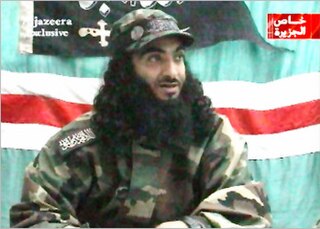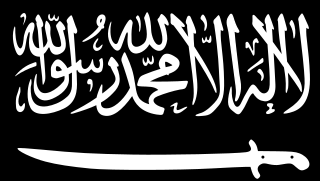
The Second Chechen War took place in Chechnya and the border regions of the North Caucasus between the Russian Federation and the breakaway Chechen Republic of Ichkeria, from August 1999 to April 2009.

Ramzan Akhmatovich Kadyrov is a Russian politician and current Head of the Chechen Republic. He was formerly affiliated to the Chechen independence movement, through his father who was the separatist-appointed mufti of Chechnya. He is a colonel general in the Russian military.

Ingushetia or Ingushetiya, officially the Republic of Ingushetia, is a republic of Russia located in the North Caucasus of Eastern Europe. The republic is part of the North Caucasian Federal District, and shares land borders with the country of Georgia to its south; and borders the Russian republics of North Ossetia–Alania to its west and north and Chechnya to its east and northeast.

Doku Khamatovich Umarov, also known as Dokka Umarov as well as by his Arabized name of Dokka Abu Umar, was a Chechen mujahid in North Caucasus. Umarov was a major military figure in both wars in Chechnya during the 1990s and 2000s, before becoming the leader of the greater insurgency in the North Caucasus. He was active mostly in south-western Chechnya, near and across the borders with Ingushetia and Georgia.
The 1999 war in Dagestan, also known as the Dagestan incursions, was an armed conflict that began when the Chechen-based Islamic International Peacekeeping Brigade (IIPB), an Islamist group led by Shamil Basayev, Ibn al-Khattab, Ramzan Akhmadov and Arbi Barayev, invaded the neighboring Russian republic of Dagestan on 7 August 1999, in support of the Shura of Dagestan separatist rebels. The war ended with a major victory for the Russian Federation and Republic of Dagestan and the retreat of the IIPB. The invasion of Dagestan alongside a series of apartment bombings in September 1999 served as the main casus belli for the Second Chechen War.
In June 2000, the North Caucasian Chechen separatist-led Chechen insurgents added suicide bombing to their tactics in their struggle against Russia. Since then, there have been dozens of suicide attacks within and outside the republic of Chechnya, resulting in thousands of casualties among Russian security personnel and civilians. The profiles of the suicide bombers have varied, as have the circumstances surrounding the bombings.

Abu al-Walid was a Saudi Arabian of the Ghamd tribe who fought as a "mujahid" volunteer in Central Asia, the Balkans, and the North Caucasus. He was killed in April 2004 in Chechnya by the Russian federal forces.

Akhmad Avdorkhanov was a former head of security for Ichkerian President Aslan Maskhadov.

Melfi Al Hussaini Al Harbi, more commonly known as Muhannad, and also known as Abu Anas, was a Mujahid Emir (commander) fighting in Chechnya. Following the death of Abu Hafs al-Urduni on 26 November 2006, he was named leader of the battalion of foreign fighters once commanded by the notorious Saudi-born Ibn al-Khattab.

Riyad-us Saliheen was the name of a small "martyr" (shahid) force of suicide attackers. Its original leader (amir) was the Chechen separatist commander Shamil Basayev. In February and March 2003, the group was designated by the United States and subsequently by the United Nations as a terrorist organization. After several years of inactivity, Riyad-us Saliheen was reactivated by the Caucasus Emirate in 2009 under the command of Said Buryatsky; following his death, Aslan Byutukayev became its new leader.

The insurgency in the North Caucasus was a low-level armed conflict between Russia and militants associated with the Caucasus Emirate and, from June 2015, the Islamic State, in the North Caucasus. It followed the official end of the decade-long Second Chechen War on 16 April 2009. It attracted volunteers from the MENA region, Western Europe, and Central Asia. The Russian legislation considers the Second Chechen War and the insurgency described in this article as the same "counter-terrorist operations on the territory of the North Caucasus region".
Aslambek Ilimsultanovich Vadalov, also known by his nom de guerre Emir Aslambek, is a Chechen rebel leader fighting in the North Caucasus. He was appointed the supreme leader of the Caucasus Emirate on 1 August 2010, though this was later retracted.
The 2010 Chechen Parliament attack took place on the morning of 19 October 2010, when three Chechen militants attacked the parliament complex in Grozny, the capital of the Chechen Republic, a federal subject of Russia. At least six people were killed, including two police officers, one parliament employee and all three suicide commandos.
Khuseyn Vakhaevich Gakayev, also known as Emir Mansur and Emir Hussein, was a mujahid Emir (commander) fighting in Chechnya. He was one of the most senior field commanders still operating in the North Caucasus prior to his death on 24 January 2013.
The Sulim Yamadayev–Ramzan Kadyrov power struggle was a feud between rival pro-Moscow Chechen warlords that exploded into armed confrontation between Yamadaev's Special Battalion "Vostok" (East) forces and Chechen President Kadyrov's militia known as the "Kadyrovtsy" following an incident in the town of Argun that led to a shootout in Gudermes on 14 April 2008. The struggle resulted in the eventual disbanding of the Vostok battalion and Yamadaev's assassination in Dubai on 30 March 2009.
Tarkhan Ismailovich Gaziyev, also known as Emir Tarkhan, is a Chechen militant commander who has fought in the Insurgency in the North Caucasus. The United States Department of State added Gaziyev to its list of Specially Designated Global Terrorists on 29 September 2015.

The Province of Nokhchicho was the Chechen-based wing of the Caucasus Emirate organisation. It was created in 2007 as one of the Emirate's six vilayats, replacing the Chechen Republic of Ichkeria.

On 4 December 2014, a group of armed militants of the jihadist organization Caucasus Emirate attacked a traffic police checkpoint outside the city of Grozny, Chechnya, Russia. The militants then entered the city and occupied the "Press House" building in the city center and a nearby school.









